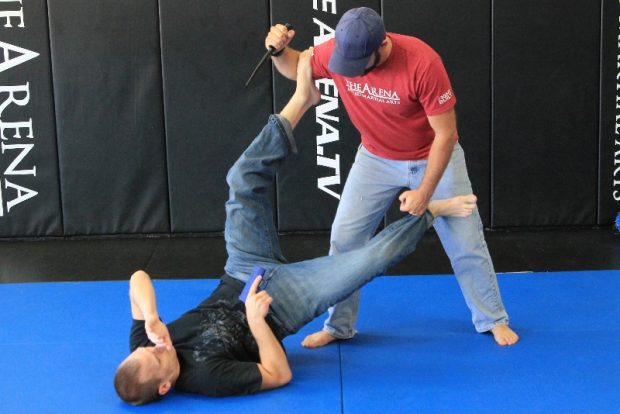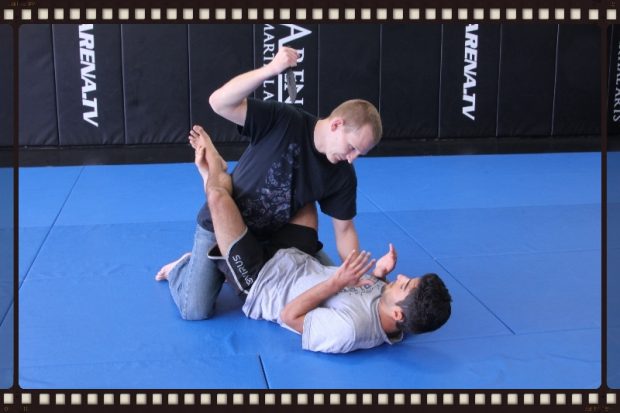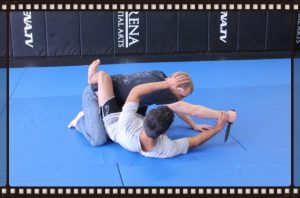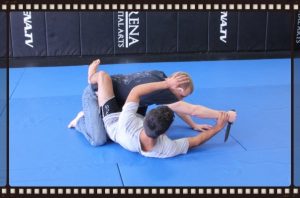If you have been reading this blog for a while, you are undoubtedly familiar with the writings of Justin White from Mad Science Defense.
Justin recently contacted me about running a few of his most successful articles as guest pieces on my blog. He is closing down the Mad Science Defense site and is focusing his endeavors on his full-time writing gig. He wanted to preserve his work for posterity and asked if I could help him. It’s great information. I’m going to share it as widely as possible.
If you are interested in Justin’s latest work, check out his website. You can also find his book on Amazon. If you are interested in his stuff, I urge you to check out both the book and the website as well as his DVD Combatives For Concealed Carry. Here’s Justin’s article:
-Greg

“Even if you have a weapon, you can still find yourself on the ground. Learning to fight from and in grounded positions is an important part of a well-rounded personal defense skillset.”
Fighting on the ground, by intent, accident or enemy action is nothing new. Grappling has been a part of hand-to-hand fighting since before human memory.
There are Greek vases adorned with wrestlers, grappling is mentioned in the Bible, and libraries in Europe have grappling manuals dating back to the dark ages. Grappling isn’t even limited to humans; when a lion wants a gazelle, he drags it into the dirt, gains dominance and chokes it out. And with the popularity of Mixed Martial Arts, Wrestling and Jiu-jitsu, more and more people have an interest in learning grappling, both the good guys and the bad guys.
Since ground-fighting is not a part of personal defense that we can afford to ignore, let’s examine some of the core principles of working on the ground. Since we are looking at grappling from a defensive approach, most of the pictures and explanations in this piece will be focused on the non-dominant positions we can find ourselves in if knocked down during a struggle, but the principles are applicable to all positions. These are the core principles of fighting on the ground.
Dynamic Posture and Position
Now you may be thinking; posture? You’re in the dirt; you’re not even upright, what posture? But how you hold and position your body on the ground is fundamental to successful ground-fighting. A dynamic posture will allow you to defend yourself more effectively and move more efficiently. Remember, “Getting off the X” applies whether you’re touching the X with your feet or your face.
When you find yourself on the ground, the following are the basics of dynamic posture. First, as soon as possible, orient toward your attacker, tuck your chin and keep your head off the ground. This will prevent your skull hitting the pavement and allows you to better detect and defend attacks. If you are struck in the head, keeping your head off the ground allows your neck to flex and absorb much of the shock. A head on the ground is a head on an anvil. It is also better to be on your side or hip, even if only slightly so, than to be flat on your back, so that you can retain mobility.
The next keystone of dynamic posture is the legs and arms. Bringing your feet toward your hip and planting will allow you to load and lift your hip, which allows you to move, buck, escape and stand. Bringing the knees and arms up also forms a sort of shield, bringing a lot of bone between you and an attacker, and enabling your grabs, framing and weapons access/protection. Whether you can efficiently move is the true test of a dynamic posture.


“Dynamic posture is all about being able to move and defend efficiently. The posture on the left is very poor; I am flat on my back with my head on the ground. On the right we see a far better posture. From this position I can now counter, defend and move in almost any direction. Not convinced? Get down on the floor and try it yourself!”
Framing
While the dynamic posture discussed above is all about moving so we can make space, bracing is all about keeping the space that we have and finding leverage points to make more space when we need it. You can frame with the hands, elbows, knees or feet by bracing them against the body of an aggressor as needed to prevent them from gaining control of your hips (bad) or your head (worse). The head and the hips are attached to either end of your spine, and you simply do not go anywhere without them.
Not only is framing important for keeping the attacker off your head and hips, but it serves a vital role in defense against strikes and contact weapons, as well. For example, by framing against an attacker’s bicep or shoulder, you can effectively shut down his ability to punch you with that arm, even though you don’t control the fist itself.
It’s important to note that framing is not pushing. When you push someone your force projects away from you, and if your attacker gives ground your momentum follows through and can leave you exposed. Framing is not about making the attacker move away, it’s about making sure he can’t crowd any closer. If he wants to back off, great! But you are not obliged to follow him. It’s a subtle but important difference that can only be really grasped with hands on training from a qualified instructor.


“On the left is an example of bad (non-existent, really) framing. By focusing only on the tool and not on the attacker, I’ve allowed David to gain control of my head. I need to turn my body towards him to mount a defense, but can’t do so with my head locked down facing away. Now my arm is isolated and it will be easy for him to defeat it and start working horrors with his knife. On the right, however, is the kind of framing we want. I keep control of my head, which aids my mobility, and by framing with the knees I place a lot of bone between us. Combine this with a dynamic posture and I have a frame that will support far more pressure than David is able to exert.”
Angle
Angle is very important, especially from the guard positions (basically any time you are on your back with an attacker who is facing you but has not gotten past your legs. This can range from the most recognized “full” guard in which the attacker is encircled by your legs, all the way out to a single foot braced against their hip). Angle contributes to leverage, and will often dictate how and where you can move, as well as how much force you can apply to a lock, throw or escape. Proper angle can be the difference between danger and safety on the ground.
To help you get your head around the concept of angle, let’s try a little experiment. Grab a couple pencils, like the yellow octagonal ones you used in grade school. Hold one pencil in each hand with your index finger near the top and your thumb and middle finger pinching the sides at the bottom. Place the two pencils flat against each other and press. As long as they’re parallel and flat, you can put a lot of force into those pencils and they won’t slip.
Now try rotating one of the pencils like the hand of a clock. Did it they suddenly slip apart, one shooting past the other? That’s because the change in angle allowed the opposing forces to come out of balance. Understanding how angle effects leverage and mobility in a grounded fight is critical, especially if you’re the pencil on the bottom. As with Framing, proper use of angle is best learned under the eye of a competent instructor.
“As I attack, David uses his legs and core to take an angle which not only avoids my line of attack but also allows him escape or to take a dominant position (shown). Using that angle has allowed him to ultimately break down my posture and isolate and attack my weapon arm. This is also a good example of ‘control the weapon, but fight the man’.”


Leverage
Leverage is what can allow a 115lb defender to flip a 205lb attacker until their back and hold them down, choke them out or break their joints. To paraphrase Archimedes, give me enough leverage, and I shall move the world. While properly applied leverage can seem like magic it is simply a result of proper distance, framing and angle.
There are many places and positions in which the human body is weak, but also many where it is very strong. When you use the principles of Dynamic Posture & Position, Framing and Angle, you will find yourself in those positions where you are stronger than your opponent. Let’s face it, a 90lb teenage girl isn’t going to just shove a grown man off her with her arms, even if she’s pumping serious iron after school. The arms alone aren’t strong enough.
But what about her legs? Every time she takes a step, just one leg not only supports her 90lbs, but throws if forward through space. That’s more than enough power the get the job done, and with the proper training and application of the above principles the leverage is there to do it. Suddenly the would-be rapist finds himself on his back with a face full of weapon, and that’s an image I think we can all get behind.
Conclusions
Fighting on the ground isn’t just about rolling around in the dirt. It’s a serious self-defense concern, and one that takes training and skill to master. Though the pursuit of grappling skills takes time, the rewards are well worth it as you will have built a realistic skillset for your unarmed combatives and an excellent delivery system for using the weapons you carry every day. Just as a skilled marksman makes better hits and a skilled boxer throws better punches, someone with a functional understanding of ground-fighting has a distinct advantage over attackers who do not. I hope I have expanded your understanding and appreciation of grappling in personal defense, and encouraged you to seek out training. Reading this article has given you knowledge, but training and practice will give you skill.









